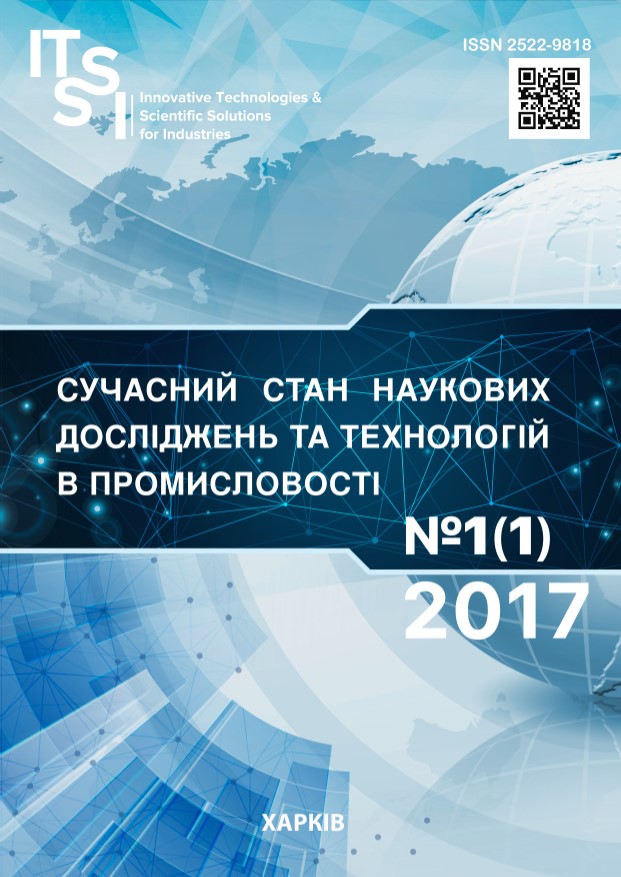MATHEMATICAL МODELLING OF SELECTING INFORMATIVE FEATURES FOR ANALYZING THE LIFE CYCLE PROCESSES OF RADIO-ELECTRONIC MEANS
DOI:
https://doi.org/10.30837/2522-9818.2017.1.082Keywords:
informative signs, identification of conditions of radio electronic equipment, monitoring of the life cycleAbstract
The subject of the study are methods and models for extracting information about the processes of the life cycle of radio electronic means at the design, production and operation stages. The goal is to develop the fundamentals of the theory of holistic monitoring of the life cycle of radio electronic means at the stages of their design, production and operation, in particular the development of information models for monitoring life cycle indicators in the production of radio electronic means. The attainment of this goal is achieved by solving such problems: research and development of a methodology for solving the problems of selecting informative features characterizing the state of the life cycle of radio electronic means; choice of informative features characterizing the state of the life cycle processes of radio electronic means; identification of the state of the life cycle processes of radio electronic means. To solve these problems, general scientific methods were used: the main provisions of functional analysis, nonequilibrium thermodynamics, estimation and prediction of random processes, optimization methods, pattern recognition. The following results are obtained. Methods for solving the problems of selecting informative features for monitoring the life cycle of radioelectronic facilities are developed by classifying the states of radioelectronic means and the processes of LC in the space of characteristics, each of which has a certain significance, which allowed finding a complex criterion and formalizing the selection procedures. When the number of a priori data is insufficient for a correct classification, heuristic methods of selection according to the criteria for using basic prototypes and information priorities are proposed. Conclusions. The solution of the problem of mathematical modeling of the efficiency functions of the processes of the life cycle of radioelectronic facilities and the choice of informative features for monitoring the life cycle of radio electronic means is presented, by classifying the states of radioelectronic means and life cycle processes in the space of characteristics, each of which has a certain significance, which allowed finding a complex criterion and formalize the selection procedure. The solution of the task of identifying the life cycle of radio electronic means involves the creation of rules that determine the state of radio electronic means. The cases of insufficient for a correct classification of the number of a priori data are considered, approximate methods of selection according to criteria for using basic prototypes and information priorities are proposed. The application of a function for dividing sets in parameter space and formulating rules that regulate the correspondence between sets of parameters and values of performance indicators makes it possible to provide identification of states in the process of monitoring the life cycle of radio electronic means.References
Birjukov, S. (2003), Optimization. Elements of the theory, MZ-Press, Moscow, 246 р.
Vasil'ev, V. (1983), Recognized by the system. Directory, Naukova dumka, Kiev, 422 р.
Nevljudov, I., Andrusevich, A., Donskov, A., (2011), "Development and application of methods for monitoring the design, manufacture and operation lifecycle of electronic means", Scientific and technical journal "Automated Control Systems and Automation Devices" [Razrabotka i primenenie metodov monitoringa processov proektirovanija, proizvodstva i jekspluatacii ZhC RJeS, Nauchno-tehnicheskij zhurnal "ASU i Pribory avtomatiki"], Vol. 156, pp. 82-89.
Kulak, D., Guiney, E. (2003), Use Cases, Addison Wesley, New York, 272 p.
Gorelik, A., Skripkin, V. (1977), Methods of recognition, Higher education school, Moscow, 222 p.
Aleksandrov, P. (1977), Introduction to set theory and general topology, Nauka, Moscow, 368 p.
Kantorovich, L., Akilov, G. (1984), Functional analysis in normed spaces, Nauka, Moscow, 368 p.
Podinovskij, V., Nogin, V. (2007), Pareto-optimal solutions of multiobjective problems: monograph [Pareto-optimal'nye reshenija mnogokriterial'nyh zadach: monografija], Fizmatlit, Moscow, 255 р.
Vishnekov, A., Ivanova, E., Safonova, I. (2006), "Methods of decision-making in distributed CAD/CAM/CAE systems. Methods for a comprehensive assessment of options under the definition of initial in-formation", Quality and FPI (CALS) technology [Metody prinjatija reshenij v raspredelennyh CAD/SAM/CAE sistemah. Metody kompleksnoj ocenki variantov v uslovijah opredelennosti ishodnoj informacii, Kachestvo i IPI(CALS)-tehnologii], Vol. 3 (11), pp. 35-40.
Kozhevnikov, A. (2000), "Methods of CALS-technologies for optimizing the choice of electric and thermal modes of electrical radio products" ["CALS-tehnologii pri optimizacii vybora jelektricheskih i teplovyh rezhimov jelektroradio izdelij"], ITPP, Vol. 3, pp. 23-26.
Downloads
How to Cite
Issue
Section
License
Copyright (c) 2018 Николай Григорьевич Стародубцев, Феликс Владимирович Фомовский, Виктория Валерьевна Невлюдова, Инна Александровна Малая, Наталия Павловна Демская

This work is licensed under a Creative Commons Attribution-NonCommercial-ShareAlike 4.0 International License.
Our journal abides by the Creative Commons copyright rights and permissions for open access journals.
Authors who publish with this journal agree to the following terms:
Authors hold the copyright without restrictions and grant the journal right of first publication with the work simultaneously licensed under a Creative Commons Attribution-NonCommercial-ShareAlike 4.0 International License (CC BY-NC-SA 4.0) that allows others to share the work with an acknowledgment of the work's authorship and initial publication in this journal.
Authors are able to enter into separate, additional contractual arrangements for the non-commercial and non-exclusive distribution of the journal's published version of the work (e.g., post it to an institutional repository or publish it in a book), with an acknowledgment of its initial publication in this journal.
Authors are permitted and encouraged to post their published work online (e.g., in institutional repositories or on their website) as it can lead to productive exchanges, as well as earlier and greater citation of published work.














